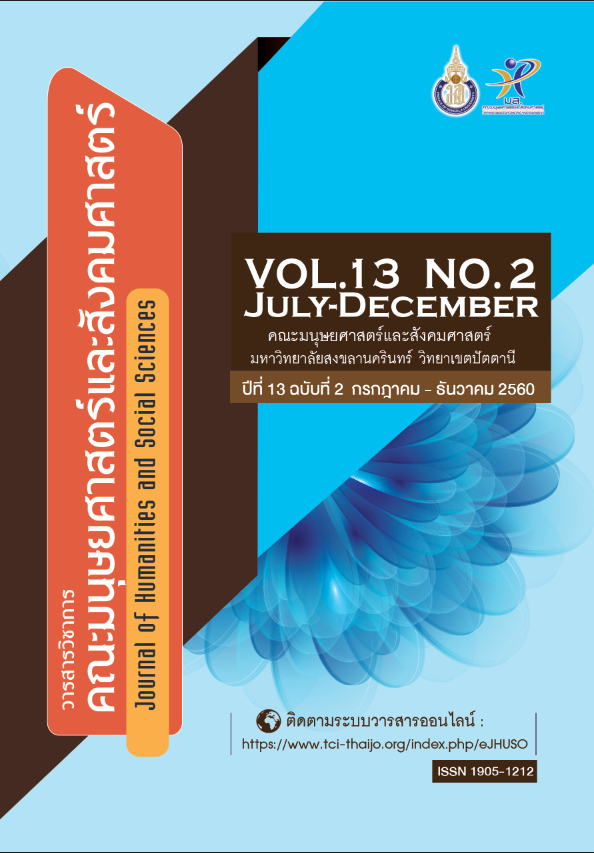การศึกษาวิเคราะห์กลวิธีการแปลวรรณกรรมนวนิยายกำลังภายใน ฉบับแปลภาษาไทยเรื่อง กระบี่ใจพิสุทธิ์ จากต้นฉบับภาษาจีน เรื่องเหลียนเฉิงเจวี๋ย(连城诀)
Keywords:
กลวิธีการแปล, วรรณกรรมนวนิยายกำลังภายใน, กระบี่ใจพิสุทธิ์, เหลียนเฉิงเจวี๋ย, The Methods Used in Translating, Martial Arts Novel, A Deadly Secret, Liān Chēng JuéAbstract
บ ท คั ด ย่ อ
บทความเรื่องนี้เป็นการศึกษากระบวนการถ่ายทอดการแปลวรรณกรรมนวนิยายกำลังภายในฉบับแปลภาษาไทยเรื่อง กระบี่ใจพิสุทธิ์ ของ น.นพรัตน์จากต้นฉบับภาษาจีนเรื่อง เหลียนเฉิงเจวี๋ย (连城诀)ของ ดร.กิมย้ง โดยศึกษาสำนวนภาษาและกลวิธีการแปลของ น.นพรัตน์ เพื่อศึกษาความเหมือนและความต่างของต้นฉบับและฉบับแปล พบว่าการแปลภาษาเรื่อง กระบี่ใจพิสุทธิ์ มีการใช้ รูปแบบการแปลที่หลากหลายได้แก่ (1) การเพิ่มคำ ตัดทอน ปรับคํา มีการแปลแบบคำต่อคำ รักษาอรรถรสแบบจีน โดยการแปลในภาษาไทยใช้คำขยายอยู่หลังคำนาม แต่ภาษาจีนมีคำขยายอยู่หน้าคำนาม ใช้วิธีการทับศัพท์ถอดเสียงเป็นภาษาแต้จิ๋วและใส่วงเล็บข้างท้ายเป็นภาษาไทย มีการใช้วิธีการปรับข้อความมากที่สุด ถ่ายทอดความหมายโดยไม่ยึดโครงสร้างของประโยคจีนเดิม ให้สอดคล้องกับความคิดของคนไทยเพื่อให้ผู้อ่านเกิดจินตนาการเสริมอรรถรส พบความบกพร่องทางความหมายไม่ตรงกับข้อความต้นฉบับภาษาบ้าง ด้านการถ่ายทอดสํานวน ภาษิตมีลักษณะคล้ายคลึงกับสํานวนไทยเป็นส่วนมาก ส่วนการแปลประโยคภาษาจีน ได้แก่ ประโยคความเดียว ประโยคความรวม การแปลภาษาไทยส่วนใหญ่จะวางส่วนขยายไว้หลังส่วนหลัก แต่ภาษาจีนจะวางส่วนขยายไว้หน้าส่วนหลักคงไว้ซึ่ง โครงสร้างไวยากรณ์ภาษาจีนเป็นส่วนมาก (2) ด้านกลวิธีทางภาษาได้ใช้กลวิธีที่หลากหลายได้แก่ อุปมา บุคลาธิษฐาน สัทพจน์ ซึ่งมี การแปลความหมายที่สอดคล้องกับต้นฉบับ พบการถ่ายทอดวรรณศิลป์ด้านร้อยกรองและ (3) ความแตกต่างวัฒนธรรมด้านภาษาในการแปล พบว่า ภูมิหลังทางวัฒนธรรมที่แตกต่างกันของไทยจีนมีอิทธิพลต่อการถ่ายทอดความหมาย อย่างชัดเจน ทั้งในด้านการใช้คำ กลุ่มคำ สำนวน ประโยคด้านวรรณศิลป์ใน รูปประโยค ภาษาไทยที่ยึดโครงสร้างภาษาจีนตามลีลานักประพันธ์อันเป็นเอกลักษณ์ของนวนิยายกำลังภายในโดยมีส่วนเหมือนกันและต่างกันกับต้นฉบับเรื่อง เหลียนเฉิงเจวี๋ย (连城诀) ฉะนั้นการใช้วิธีการแปลแบบคำต่อคำผสมผสานร่วมกับการแปลแบบเอาความหมาย เป็นการแปลที่นิยมใช้มากที่สุด
A b s t r a c t
IIn this article, the researcher studied No Nopparat’s translation process in Thai translated version of the Chinese martial arts novel names Liān Chēng Jué (A Deadly Secret) authored by Dr. Louis Chá (Zhá liáng yōng), who writes under the pen name of Jīn Yōng. The researcher also examines the style and translation methods used by No Nopparat, so as to determine similarities and differences between the Chinese text and the Thai text of the novel. Findings are as follows. (1) In translating Liān Chēng Jué (A Deadly Secret), No Nopparat utilized variegated techniques. The researcher found that wording was added, eliminated, and altered. Moreover, instances of literal translation and poetic embellishment were found in examining No Nopparat’s endeavor to carry over into Thai the cultural sensibilities inherent in the text translated. In Thai, modifiers follow the nouns or verbs they modify. In Chinese languages, modifiers generally precede the nouns. In translating, No Nopparat (6) transliterated Chinese (Teochew) words into Thai and placed them in brackets. Altering the text was the translation technique most frequently used. The meaning was transferred from Chinese to Thai while the sentential structures of the original version were largely discarded in order to help Thai readers understand the novel better. However, the researcher found that the meaning of the Thai text did not always match the meaning of the original Chinese text. In these cases, Chinese text expressions in translation became very close in meaning to the translated Thai expressions. In respect to sentential syntax, in translating Chinese simple and compound sentences into Thai, it was found that the translator had no choice but to place modifiers— adjectives and adverbs after the main parts of speech, nouns and verbs. However, in Chinese languages, the main parts of speech generally precede modifiers. Thus, it is impossible to transfer all Chinese grammatical into the Thai translated version. (2) In attempting to maintain the meaning of the original text, the translator used a variety of literary techniques. Techniques used included similes, personification, and onomatopoeia. (3) In respect to the effects of cultural differences on the language used in the translation, the researcher found that these differences clearly influenced the transfer of meaning from the original Chinese text to the Thai translation. Cultural differences influenced the use of words, phrases, and particular expressions. Moreover, in the translation, Thai sentences were adjusted by particular styles of the translator as he had experience in the traditional genre of martial arts storytelling. In conclusion, the Thai translation is both similar and dissimilar to the original novel, Liān Chēng Jué (A Deadly Secret). Therefore, in the researcher’s view, word-for-word translation (literal translation) should be artfully interspersed with free translation. This is the preferable type of translation.
Downloads
Published
How to Cite
Issue
Section
License
บทความนี้ได้รับการตีพิมพ์เป็นของวารสารวิชาการคณะมนุษยศาสตร์และสังคมศาสตร์ คณะมนุษยศาสตร์และสังคมศาสตร์ มหาวิทยาลัยสงขลานครินทร์ วิทยาเขตปัตตานี






